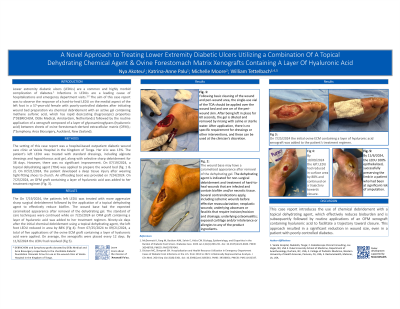Case Series/Study
(CS-162) A Novel Approach to Treating a Diabetic Lower Extremity Ulcer Utilizing a Combination of a Topical Dehydrating Chemical Agent & Ovine ECM Grafts
Containing a Layer of Hyaluronic Acid
Friday, May 2, 2025
7:45 PM - 8:45 PM East Coast USA Time

Leka Akoteu, RN – Vaiola Hospital; Katrina-Anne Palu, Podiatrist – Vaiola Hospital; Michelle Moore, RN – Kaleidoscope Clinical Consulting
Introduction:
Lower extremity diabetic ulcers (LEDUs) are a common and highly morbid complication of diabetes. Infections in LEDUs are a leading cause of hospitalizations and emergency department visits. The aim of this case report was to observe the response of a hard-to-heal LEDU on the medial aspect of the left foot in a 57-year-old female with poorly-controlled diabetes after initiating wound bed preparation via chemical debridement with an active gel containing methane sulfonic acid, which has rapid desiccating (hygroscopic) properties followed by the routine application of a xenograft composed of a layer of glycosaminoglycans (hyaluronic acid) between sheets of ovine forestomach-derived extracellular matrix (ECM).
Methods:
The setting of this case report was a hospital-based outpatient diabetic wound care clinic at Vaiola Hospital in the Kingdom of Tonga. Her A1c was 13%. The patient’s left diabetic foot ulcer (DFU) was treated with standard dressings, including alginate dressings and hypochlorous acid gel, along with selective sharp debridement for 38 days. However, there was no significant improvement. On 07/19/2024, a topical dehydrating agent was applied to prepare the wound bed. On 07/21/2024, the patient developed a deep tissue injury after wearing tight-fitting shoes to church. An offloading boot was provided on 7/24/2024. On 7/25/2024, an ovine ECM graft containing a layer of hyaluronic acid was added to her treatment regimen.
Results:
On 7/19/2024, the patients left LEDU was treated with more aggressive sharp debridement followed by the application of a topical dehydrating agent to effectively reduce biofilm. The wound base had the expected caramelized appearance after removal of the dehydrating gel. The standard of care techniques were continued while on 7/25/2024 an ovine ECM graft containing a layer of hyaluronic acid was added to her treatment regimen. Ninety-six days after the initial chemical debridement using a topical dehydrating agent, the left LEDU reduced in area by 88%. Between 07/25/2024 to 09/21/2024, a total of five applications of the ovine ECM graft containing a layer of hyaluronic acid were applied. On average, the xenografts were placed every 12 days.
Discussion:
This case report introduces the use of chemical debridement with a topical dehydrating agent, which effectively reduces bioburden and is subsequently followed by routine applications of an ovine ECM combined with hyaluronic acid to facilitate a trajectory toward closure. This approach resulted in a significant reduction in wound size, even in a patient with poorly controlled diabetes.
Lower extremity diabetic ulcers (LEDUs) are a common and highly morbid complication of diabetes. Infections in LEDUs are a leading cause of hospitalizations and emergency department visits. The aim of this case report was to observe the response of a hard-to-heal LEDU on the medial aspect of the left foot in a 57-year-old female with poorly-controlled diabetes after initiating wound bed preparation via chemical debridement with an active gel containing methane sulfonic acid, which has rapid desiccating (hygroscopic) properties followed by the routine application of a xenograft composed of a layer of glycosaminoglycans (hyaluronic acid) between sheets of ovine forestomach-derived extracellular matrix (ECM).
Methods:
The setting of this case report was a hospital-based outpatient diabetic wound care clinic at Vaiola Hospital in the Kingdom of Tonga. Her A1c was 13%. The patient’s left diabetic foot ulcer (DFU) was treated with standard dressings, including alginate dressings and hypochlorous acid gel, along with selective sharp debridement for 38 days. However, there was no significant improvement. On 07/19/2024, a topical dehydrating agent was applied to prepare the wound bed. On 07/21/2024, the patient developed a deep tissue injury after wearing tight-fitting shoes to church. An offloading boot was provided on 7/24/2024. On 7/25/2024, an ovine ECM graft containing a layer of hyaluronic acid was added to her treatment regimen.
Results:
On 7/19/2024, the patients left LEDU was treated with more aggressive sharp debridement followed by the application of a topical dehydrating agent to effectively reduce biofilm. The wound base had the expected caramelized appearance after removal of the dehydrating gel. The standard of care techniques were continued while on 7/25/2024 an ovine ECM graft containing a layer of hyaluronic acid was added to her treatment regimen. Ninety-six days after the initial chemical debridement using a topical dehydrating agent, the left LEDU reduced in area by 88%. Between 07/25/2024 to 09/21/2024, a total of five applications of the ovine ECM graft containing a layer of hyaluronic acid were applied. On average, the xenografts were placed every 12 days.
Discussion:
This case report introduces the use of chemical debridement with a topical dehydrating agent, which effectively reduces bioburden and is subsequently followed by routine applications of an ovine ECM combined with hyaluronic acid to facilitate a trajectory toward closure. This approach resulted in a significant reduction in wound size, even in a patient with poorly controlled diabetes.

.jpg)